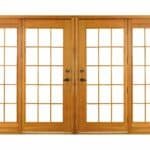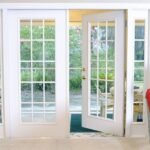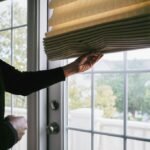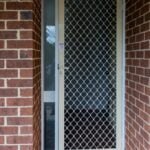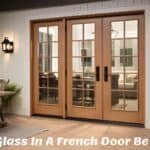Today, we’re going to explore an important aspect of French doors – the required clearance. When it comes to installing these elegant doors in your home or office, one question that often arises is, “How much clearance do you need for French doors?”
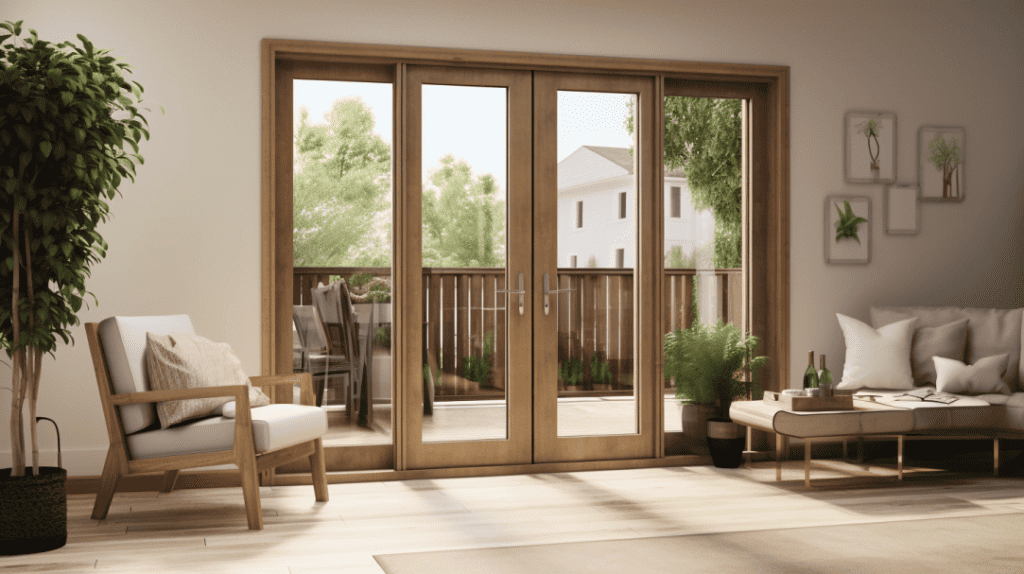
The answer to that question depends on various factors. One of the primary considerations is the type of French door you have or plan to install. Some French doors swing inward, while others swing outward. The direction of the swing will impact the necessary clearance. Additionally, you’ll need to account for the width of the door itself and any additional components, such as handles or locks, that may protrude. Building codes and regulations may also dictate specific minimum clearance requirements for safety purposes. Therefore, consulting local building authorities or professionals is crucial to ensure compliance.
Understanding the required clearance for French doors is crucial before embarking on installation. Take into account the door’s swing direction, width, and any protruding components, while also considering local codes and regulations. Doing so can ensure a seamless installation that blends aesthetics with practicality.
Understanding French Doors
French doors are a popular architectural feature that adds elegance and functionality to any space. These unique doors consist of two hinged panels on the sides and typically have multiple glass panes. They are commonly used to connect indoor and outdoor areas, such as a patio or garden, allowing for a seamless transition between the two spaces.
Definition of French Doors
French doors, also known as French windows, are characterized by their classic design and distinctive look. They are designed to provide a full outside view while allowing ample natural light to filter into the room. The glass panes in the doors enhance the aesthetic appeal and create an illusion of a larger, more open space.
Historical Overview of French Doors
The origin of French doors can be traced back to the Renaissance period in France. They were initially introduced as a means of bringing in more natural light to interiors and providing access to outdoor areas. Over the centuries, French doors have evolved in design, symbolising architectural style and sophistication.

Features of French Doors
Many variations of Lorem Ipsum passages are available, but the majority have suffered alteration in some form by injected humour or randomized words.
Importance of Adequate Clearance
When installing French doors, it is crucial to consider the required clearance. Clearance refers to the space around the gates to ensure smooth operation and functionality. Inadequate support can lead to several issues, including restricted movement, potential damage to the doors, and compromised safety.
Functionality of Doors
Adequate clearance plays a vital role in ensuring that French doors can open and close properly without any obstructions. Insufficient clearance may result in the doors sticking or rubbing against the frame, making it difficult to operate them smoothly. On the other hand, providing excessive clearance can compromise the structural integrity of the doors and affect their stability.
Aesthetics of French Doors
Proper clearance also contributes to the overall visual appeal of the French doors. When installed with the right amount of clearance, the doors align perfectly with the surrounding walls and create a seamless and polished look. Insufficient or excessive clearance can disrupt the symmetry and proportions of the doors, detracting from their aesthetic charm.
Safety Considerations
Clearance is a critical factor in ensuring the safety of individuals using French doors. In case of emergencies or the need for a quick exit, it is essential to have sufficient clearance to allow for a swift and unimpeded passage. Insufficient clearance can impede the evacuation process, potentially putting occupants at risk. Additionally, proper clearance ensures that the doors do not pose a hazard by swinging too close to nearby furniture or objects.
French Door Installation Guidelines
| Category | Details |
|---|---|
| Clearance between door edges | 1/8″ of clearance per door edge, 60 1/2″ for double French doors |
| Rough opening size | Add 2″ to width, 2 1/2″ to height; 82 1/2″ height for standard interior door |
| Threshold gap | Allow 3mm on both hinge sides, 9mm clearance from the floor |
| Standard interior French doors | 80 inches high by 36 inches wide per door, 72 inches wide overall |
| Other sizes | Available in around 5 and 8 feet in width; 30 to 72 inches wide per door, 2-inch increments |
How to Determine the Required Clearance
Determining the required clearance for French doors involves understanding doorway measurements, employing accurate measuring techniques, and considering specific factors that affect clearance requirements.
Understanding Doorway Measurements
Before installing French doors, measuring the width and height of the intended doorway accurately is essential. The measurements should be taken from the inside edges of the door frame. This ensures that the doors will fit snugly within the available space.
Measuring Techniques
To determine the required clearance, measure the width of each individual door panel, including any protruding hardware or trim. Add the measurements of both panels together to get the total width of the doors when fully open. This measurement will help determine the minimum clearance needed on either side of the doorway.
Similarly, measure the height of each door panel, including any additional size required for the door frame components. Adding the measurements of both panels will determine the overall height clearance required for the French doors.
Considerations for Clearance Measurements
In addition to the size of the French doors, several other factors influence the required clearance. Considerations include the type of hinges used, the amount of swing required for the doors to open fully, the addition of door stops or weatherstripping, and the presence of any architectural features around the doorway.
It is important to consult manufacturer guidelines and local building codes for specific clearance requirements, as they may vary depending on the type and design of the French doors.
Installation Process for French Doors
Installing French doors involves several steps, starting from preparing the doorway to ensuring proper clearance during and after installation.
Preparing the Doorway
Before installing French doors, the doorway should be adequately prepared. This includes removing any existing doors, frames, or trim. The structural integrity of the doorway should be checked, and any necessary repairs or reinforcements should be carried out to ensure stability.
Installing the Doors
The French doors should be carefully aligned and installed within the doorway, following manufacturer instructions and using appropriate hardware. It is crucial to ensure that the doors are plumb, level, and square for proper operation.
Checking the Clearance
During installation, it is essential to continuously monitor and adjust the clearance to ensure it meets the required specifications. This includes checking the functionality of the doors as they are being installed and making necessary adjustments to the hinges or hardware if any issues arise.
Dealing with Insufficient Clearance
In some cases, despite careful planning and execution, the installed clearance for French doors may be insufficient. This can lead to various problems that require corrective measures.
Common Problems
Insufficient clearance may result in the doors rubbing against the frame, causing friction and potential damage to both the doors and the surrounding structure. It can also lead to difficulty in opening and closing the doors smoothly, compromising their functionality. In extreme cases, inadequate clearance may cause the doors to become misaligned or warp over time.
Solutions for Correction
If the installed clearance is insufficient, several possible solutions exist to address the issue. These may include adjusting or replacing the hinges to allow for more swing or reducing the thickness of the door frame components to create additional space. In cases where significant modifications are required, professional assistance may be necessary to ensure proper correction.
Tools Required for Installing French Doors
Installing French doors requires specific tools to ensure accurate measurements, proper installation, and adherence to safety guidelines.

Measuring Instruments
Various measuring instruments are essential to determine the required clearance for French doors. These may include a tape measure, level, and combination square to measure and accurately align the doors during installation. A laser level or plumb line can also be employed to ensure the doors are properly vertical and aligned.
Hardware Tools
Installing French doors often involves using different types of hardware tools. These may include a screwdriver, drill, chisel, hammer, and a mitre or circular saw to cut any required trim or framing components. Using the appropriate tools for each task is essential to ensure proper installation and prevent damage to the doors or surrounding area.
Safety Equipment
Safety should always be a priority during the installation process. Essential safety equipment, such as gloves and safety goggles, should be worn to protect against any potential hazards. Additionally, using a dust mask or respirator when working with certain materials, such as fibreglass or wood dust, is recommended to protect against respiratory irritation.
Maintenance of French Doors and Clearance
Once French doors are installed, proper maintenance is essential to preserve their functionality and maintain the required clearance over time.

Routine Maintenance Steps
Regular maintenance should include cleaning the doors and glass panes, lubricating the hinges and hardware, inspecting for any signs of wear or damage, and addressing any issues promptly. This helps prevent debris or buildup that may hinder the doors’ operation and allows for the timely detection and correction of any clearance-related problems.
Signs of Needing Adjustments
During routine maintenance, it is essential to identify any signs that indicate adjustments may be needed to maintain the required clearance. These signs may include difficulty in opening or closing the doors, unusual noises or squeaking, visible rubbing or scraping marks, or a noticeable change in the alignment of the entries within the frame. Any such signs should be addressed promptly to prevent further damage or deterioration.
Maintaining Correct Clearance
Following manufacturer guidelines for specific maintenance requirements is crucial to maintain the required clearance. This may involve periodic inspections of the doors, hinges, and hardware and attention to maintaining the proper lubrication. Regularly checking the doors’ functionality and clearance ensures that any potential issues are identified early and resolved promptly.
The Role of Clearance in French Door Performance
Clearance plays a significant role in the overall performance of French doors and affects various aspects of their functionality and energy efficiency.
Interaction with Door Function
Adequate clearance allows the doors to function smoothly and effectively. It ensures the doors can be opened and closed without obstructions, allowing for easy access between indoor and outdoor spaces. Proper clearance also prevents unnecessary wear and tear on the doors and reduces the risk of damage to the surrounding structure.
Impact on Energy Efficiency
French doors often have energy-efficient features, such as insulated glass and weatherstripping, to minimize heat transfer and enhance energy efficiency. However, if the doors do not have the required clearance, the effectiveness of these energy-saving features may be compromised. Insufficient clearance can create gaps or leaks, allowing drafts, moisture, and unwanted heat transfer, thus reducing the doors’ overall energy efficiency.
Noise and Light Control
Clearance also influences the doors’ ability to provide noise and light control. Properly installed and aligned French doors with the correct clearance help ensure a tight seal, minimizing noise transmission from one space to another. Additionally, the clearance affects how well the doors can block or allow natural light to enter a room. The optimal clearance provides for the maximum utilization of glass panes without compromising privacy or light control needs.
Common Mistakes with Clearance
When installing French doors, there are several common mistakes to avoid to ensure the proper clearance is achieved.
Incorrect Measurement
One of the most common mistakes is inaccurate measurement of the doorway and the subsequent failure to provide the required clearance. Care should be taken to precisely measure the width, height, and additional components to determine the correct clearance needed for the doors.
Providing Excessive or Insufficient Clearance
Both excessive and insufficient clearance can pose problems. While too much clearance can affect the stability of the doors and compromise their visual appeal, too little clearance leads to operational issues, potential damage, and safety concerns.
Negligence in Monitoring Clearance
Once the French doors are installed, regularly monitoring and maintaining the clearance is essential. Insufficient inspection for any changes or signs of clearance-related issues may result in further complications. Promptly addressing clearance concerns can prevent problems, ensuring the doors’ long-term functionality.
What Are the Standard Clearance Requirements for French Doors?
When it comes to standard clearance requirements for French doors made to measure, it’s important to leave enough space around the doors for smooth and easy operation. Typically, it’s recommended to have at least 2 inches of clearance on each side, as well as above and below the doors.
Summary: Clearance for French Doors
Understanding the required clearance for French doors is crucial for their successful installation, functionality, and longevity. Adequate support ensures smooth operation, enhances the aesthetic appeal and promotes safety. Accurate measurements can determine it, as careful consideration of various factors and adherence to manufacturer guidelines.
To maintain the required clearance, routine maintenance is essential. Regular inspections, lubrication, and prompt attention to signs of needing adjustments help preserve the doors’ performance and prevent potential damage. Clearance is fundamental to the doors’ function, energy efficiency, noise and light control, and overall performance, making it an integral aspect of French door installation and maintenance. By avoiding common mistakes and following best practices, homeowners and designers can enjoy the beauty and functionality of French doors with the appropriate clearance.
Reference articles:
https://www.diychatroom.com/threads/how-much-clearance-do-i-need-between-double-french-doors.13654/
https://www.finehomebuilding.com/project-guides/windows-doors/the-trick-to-hanging-french-doors
https://www.doorstop.com.au/blog/how-much-gap-do-you-leave-between-double-doors
https://www.vibrantdoors.co.uk/doors/external-french-doors/advice/french-door-sizing-and-fitting
https://www.mrrogerswindows.com/determine-size-double-french-door-rough-opening/

I’m James Davis, a carpenter with eight years of experience in carpentry services, repairs, installations, renovations, and maintenance of interior doors. I have a diploma in carpentry and joiner trade from the Education Skills Australia Institute and take pride in delivering high-quality results to ensure customer satisfaction. I’m a blog writer for Octopus Doors Company and enjoy sharing my knowledge and tips on maintaining security measures and choosing the right door materials, paints, or handle styles. I specialize in custom-made interior doors and strive to make every home look fabulous. Contact me anytime for help with door-related issues.

